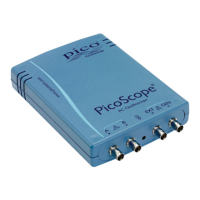Prog ramming the 3000A Series oscilloscopes10
Copyright © 2011-2013 Pico Technology Limited. All rights reserved.ps3000abpg.en r9
2.7.2
Rapid block mode
In normal block mode, the PicoScope 3000A Series scopes collect one waveform at a
time. You start the the device running, wait until all samples are collected by the
device, and then download the data to the PC or start another run. There is a time
overhead of tens of milliseconds associated with starting a run, causing a gap between
waveforms. When you collect data from the device, there is another minimum time
overhead which is most noticeable when using a small number of samples.
Rapid block mode allows you to sample several waveforms at a time with the minimum
time between waveforms. It reduces the gap from milliseconds to less than 2
microseconds (on fastest timebase).
See Using rapid block mode for details.
2.7.2.1 Using rapid block mode
You can use rapid block mode with or without aggregation. With aggregation, you
need to set up two buffers for each channel to receive the minimum and maximum
values.
Without aggregation
1. Open the oscilloscope using ps3000aOpenUnit.
2. Select channel ranges and AC/DC coupling using ps3000aSetChannel.
3. [MSOs only] Set the digital port using ps3000aSetDigitalPort.
4. Using ps3000aGetTimebase, select timebases until the required nanoseconds per
sample is located.
5. Use the trigger setup functions ps3000aSetTriggerChannelConditionsV2,
ps3000aSetTriggerChannelDirections and ps3000aSetTriggerChannelProperties to
set up the trigger if required.
6. [MSOs only] Use the trigger setup functions
ps3000aSetTriggerDigitalPortProperties to set up the digital trigger if required.
7. Set the number of memory segments equal to or greater than the number of
captures required using ps3000aMemorySegments. Use ps3000aSetNoOfCaptures
before each run to specify the number of waveforms to capture.
8. Start the oscilloscope running using ps3000aRunBlock.
9. Wait until the oscilloscope is ready using the ps3000aIsReady or wait on the
callback function.
10. Use ps3000aSetDataBuffer to tell the driver where your memory buffers are.
11. Transfer the blocks of data from the oscilloscope using ps3000aGetValuesBulk.
12. Retrieve the time offset for each data segment using
ps3000aGetValuesTriggerTimeOffsetBulk64.
13. Display the data.
14. Repeat steps 7 to 13 if necessary.
15. Stop the oscilloscope using ps3000aStop.
With aggregation
To use rapid block mode with aggregation, follow steps 1 to 9 above, then proceed as
follows:
10a. Call ps3000aSetDataBuffer or (ps3000aSetDataBuffers) to set up one pair of
buffers for every waveform segment required.
11a. Call ps3000aGetValuesBulk for each pair of buffers.
12a. Retrieve the time offset for each data segment using
ps3000aGetValuesTriggerTimeOffsetBulk64.
Continue from step 13 above.

